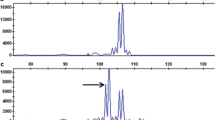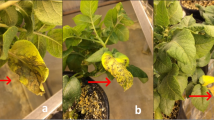Abstract
During 1980 and 1981 potato cultivars and breeding selections, including cultivated species and their hybrid derivatives, were evaluated for resistance to the green peach aphid (GPA),Myzus persicae (Sulzer), and to potato leafroll virus (PLRV). Criteria used were the number of aphids which colonized the clones in free choice field experiments and the number of plants derived from these experiments which showed symptoms of PLRV infection.
Generally, greater resistance to GPA was found inSolarium tuberosum gp.andigena selections and hybrids than in gp.tuberosum cultivars. There were approximately fourfold differences in season-mean GPA levels among the clones tested each year. Forty-two families, representing a cross-section of the USDA breeding populations at the University of Idaho Research and Extension Center, Aberdeen, showed a similar range in colonization levels. Resistance to GPA colonization appeared to be more prevalent in gp.andigena, gp.phureja, and gp.stenotonum derivatives.
There was a weak positive correlation (r2 = .34, P = .01) between foliar total glycoalkaloids and season-mean GPA colonization levels for six clones representing the range of observed resistance to GPA.
Resistance to GPA colonization was apparently not directly related to resistance to PLRV infection. Katahdin, for example, was relatively susceptible to GPA colonization but very resistant to PLRV infection whereas selection A69657-4 (gp.andigena) was among the most resistant to GPA colonization but among the more susceptible to PLRV infection. Breeding for resistance to GPA colonization therefore may not be as promising for PLRV control as developing PLRV resistant cultivars.
Resumen
Durante la campaña de 1980 y 1981 variedades y selecciones que incluyó especies cultivades y sus híbridos, fueron evaluados para resistencia al áfido verdeMyzus persicae (Sulzer), como también al virus del enrollamiento (PLRV). Los criterios utilizados fueron los números de áfidos que colonizan los clones en experimentos de “preferencia” en campos y en plantas derivadas de estos experimentos que muestran síntomas de infección del virus.
Se encontró generalmente más resistencia el áfido en selecciones deS. tuberosum ssp.andigena y sus hibridos que en los cultivares deS. tuberosum. Las diferencias encontradas eran de aproximadamente 4 veces en cuanto al promedio obtenido de campaña entre clones probadas cada año.
Cuarenta y dos familias que representan horizontalmente al programa de mejoramiento del USDA llevado a cabo en la Estación Experimental de la Universidad de Idaho en Aberdeen, mostraron un rango similar de niveles de colonización. Resistencia a niveles de colonización aparentemente es más prevalente a hibridos del grupo Andigena, Phureja y Stenotonum.
Se encontró una correlación débil positiva (r2=.34 P = 0.1) entre glycoalkaloides foliares y promedio de niveles de colonización del áfido en (seis) 6 clones que representan el rango de resistencia observada.
Resistencia a colonización del áfido aparentemente no está directamente relacionada a resistencia al virus del enrollamiento. Katahdin, por ejemplo, fue relativamente susceptible a la colonización del áfido pero muy resistente al virus del enrollamiento mientras que la selección A69657-4 (grupo Andigena) situada entre las más resistentes a la colonización del áfido, pero entre las más susceptibles a la infección del virus del enrollamiento. El mejoramiento para resistencia a colonización del áfido no aparenta ser promisorio para desarrollar cultivares resistentes al virus del enrollamiento.
Similar content being viewed by others
Literature Cited
Baerecke, M.L. 1958. Blatrollresistonzzuchtung.In Handbuch der Fflanzenzuchtung, III. Zuchtung der knollen-und worzelfrechtarten, pp. 97–106, Eds. H. Kappert and W. Rudorf. Paul Parey.
Bagnall, R.H. 1977. Resistance to the aphid-borne viruses in the potato.In Aphids as virus vectors, pp. 501–526, Eds. K.F. Harris and K. Maramorosch. New York, Academic Press. 559 p.
Bishop, G.W., H.W. Homan, L.E. Sandvol and R.L. Stoltz. 1982. Management of potato insects in the western states. West Reg Ext Pub 64, 31 pp.
Bishop, G.W. 1965. Green peach aphid distribution and potato leafroll virus occurrence in the seed-potato producing areas of Idaho. J Econ Entomol 58:150–153.
Byrne, David N. and Guy W. Bishop. 1979. Relationship of green peach aphid numbers to spread of potato leaf roll virus in southern Idaho. J Econ Entomol 72:809–811.
Gibson, R.W. 1971. Glandular hair providing resistance to aphids in certain wild potato species. Ann Appl Biol 68:113–119.
Ochoa, C.M. 1980. A new tuber-bearingSolanum potentially useful for breeding for aphid resistance. Am Potato J 57:387–390.
Radcliffe, E.B. and F.I. Lauer. 1966. A survey of aphid resistance in the tuber-bearingSolanum (Tourn.) L. species. Minn Agric Exp Stn Tech Bull 253, 23 p.
Radcliffe, E.B. and F.I. Lauer. 1967. Insect resistance in the wildSolanum species. Proc N Centr Br Entomol Soc Am 22:165–167.
Radcliffe, E.B. and F.I. Lauer. 1968. Resistance ofMyzus persicae (Sulzer),Macrosiphum euphorbiae (Thomas), andEmpoasca fabae (Harris) in the wild tuber-bearingSolarium (Tourn.) L. species. Minn Agric Exp Stn Tech Bull 259, 27 p.
Radcliffe, E.B. and F.I. Lauer. 1970. Further studies on resistance to green peach aphid and potato aphid in wild tuber-bearingSolarium species. J Econ Entomol 63:110–114.
Sams, D.W., F.I. Lauer and E.B. Radcliffe. 1976. Breeding behavior of resistance to green peach aphid in tuber-bearingSolarium germplasm. Am Potato J 53:23–29.
Sinden, S.L. and R.E. Webb. 1974. Effect of environment on glycoalkaloid content of six potato varieties at 39 locations. USDA, ARS Res Bull 1472, 30 pp.
Sinden, S.L., L.L. Sanford and S.F. Osmon. 1980. Glycoalkaloids and resistance to the Colarado potato beetle inSolarium chacoense Bitter. Am Potato J 57:331–343.
Tingey, Ward M. and Stephen L. Sinden. 1982. Glandular pubescence, glycoalkaloid composition and resistance to the green peach aphid, potato leafhopper, and potato flea-beetle inSolarium berthaultii 1982. Am Potato J 59:95–106.
Webb, R.E., D.R. Wilson, J.A. Frank, J.R. Shumaker, B. Graves and M.R. Henninger. 1981. BelRus: A new russet skin potato variety, combining high quality, pest resistance, and adaptation to the northeastern United States and Florida. Am Potato J 58:111–116.
Author information
Authors and Affiliations
Additional information
Published with the approval of the Director of the Idaho Agricultural Experiment Station as Research Paper No. 8479.
Rights and permissions
About this article
Cite this article
Mndolwa, D., Bishop, G., Corsini, D. et al. Resistance of potato clones to the green peach aphid and potato leafroll virus. American Potato Journal 61, 713–722 (1984). https://doi.org/10.1007/BF02888974
Accepted:
Issue Date:
DOI: https://doi.org/10.1007/BF02888974




